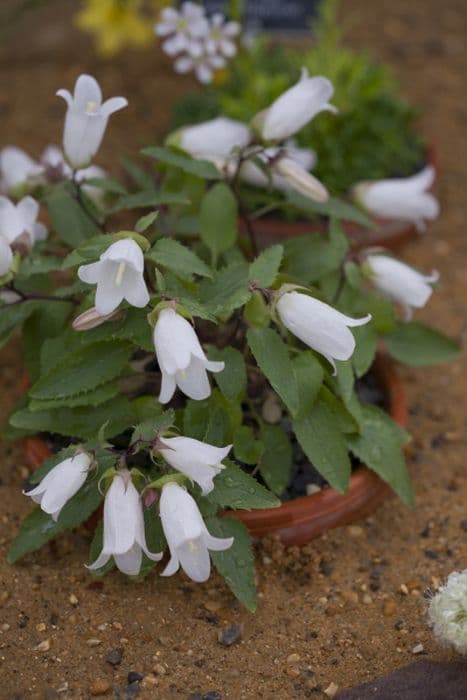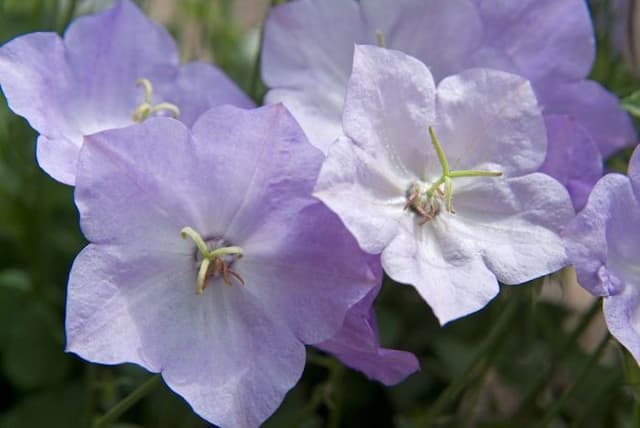Devil's tobacco Lobelia tupa

ABOUT
Lobelia tupa, commonly known as devil's tobacco, is a visually striking plant with distinctive features. The foliage of devil's tobacco predominantly comprises deep green leaves that are lance-shaped, with a slightly serrated edge that encases the stem in a rosette formation at the base, before ascending the stem in an alternating pattern. The most remarkable characteristic of devil's tobacco is its flowers. These blossoms are tubular, with a flair at their five-lobed mouth, resembling elongated trumpets. The color of the flowers is a vibrant red or sometimes a shade that approaches a deep orange. They stand out against the foliage and are arranged in loose, terminal spikes which cluster at the top of the stems, giving them a flamboyant and showy aspect. The attractiveness of devil's tobacco is further enhanced by its robust, upright stature and the way it produces multiple flowering stems from a single base. The entire plant is covered with a fine, velvety down, lending it a soft texture. As the season progresses, the flowers give way to seed capsules, which also have an interesting appearance, though less showy than the flowers they replace. Overall, devil's tobacco has a bold and dramatic look, with a wild, almost exotic charm, making it a distinctive presence in any garden or natural setting where it is found.
About this plant
 Names
NamesFamily
Campanulaceae
Synonyms
Devil's Tobacco, Tupa, Tabaco del Diablo
Common names
Tupa salicifolia, Dortmanna tupa, Rapuntium tupa, Laurentia tupa.
 Toxicity
ToxicityTo humans
Devil's tobacco is known to be toxic to humans. Ingesting parts of the plant can lead to symptoms such as nausea, vomiting, diarrhea, coughing, weakness, confusion, and in severe cases, respiratory failure. The plant contains several alkaloids, particularly lobeline, which can disrupt neurotransmitter processes in the body. It is important to avoid consuming any part of devil's tobacco to prevent these toxic consequences.
To pets
Devil's tobacco is also toxic to pets. If ingested, pets may experience symptoms including vomiting, diarrhea, excessive salivation, lethargy, and abnormal heart rate. Due to the presence of toxic alkaloids such as lobeline, ingestion can lead to severe neurological and respiratory complications, which could be fatal. It is imperative to ensure that pets do not consume any part of the devil's tobacco plant.
 Characteristics
CharacteristicsLife cycle
Perennials
Foliage type
Deciduous
Color of leaves
Green
Flower color
Red
Height
6 feet (1.8 meters)
Spread
2 feet (0.6 meters)
Plant type
Shrub
Hardiness zones
8
Native area
Chile
Benefits
 General Benefits
General Benefits- Ornamental Value: Lobelia tupa, commonly known as Devil’s Tobacco, features striking red, tubular flowers that can add visual interest to garden landscapes.
- Wildlife Attraction: The flowers of Devil’s Tobacco can attract hummingbirds and pollinators such as bees and butterflies, contributing to biodiversity.
- Tolerance to Poor Soils: Devil’s Tobacco is known to tolerate less fertile soil conditions, making it suitable for a variety of garden settings.
- Drought Resistance: Once established, Devil’s Tobacco can withstand periods of drought, making it a good choice for water-wise gardening.
- Coastal Gardening: Being native to Chile, Devil’s Tobacco is often tolerant of coastal conditions, including salt spray and sandy soils.
- Architectural Interest: With its tall flower spikes and large, robust leaves, Devil’s Tobacco can serve as a focal point or architectural feature in a garden design.
- Erosion Control: The robust root system of Devil’s Tobacco can help stabilize soil and control erosion on slopes or in areas prone to soil degradation.
 Medical Properties
Medical Properties- Analgesic: Traditionally used for pain relief.
- Antiasthmatic: Used in treating respiratory issues like asthma.
- Sedative: Employed for its calming effects.
- Emetic: Used to induce vomiting for detoxification.
- Expectorant: Utilized to help expel phlegm from the airways.
 Air-purifying Qualities
Air-purifying QualitiesThis plant is not specifically known for air purifying qualities.
 Other Uses
Other Uses- Lobelia tupa, commonly known as "Tupa," has been traditionally used as a source of dye. The plant's intense red pigments have been extracted for use in natural dyeing processes.
- The plant's striking flowers and foliage make it an ideal candidate for ornamental use in themed gardens, such as those designed to attract hummingbirds or butterflies.
- In some cultures, Tupa has been used in ritualistic ceremonies for its hallucinogenic properties, although this use is not widely recommended or legal due to potential toxicity.
- The fibers from Tupa's stems can be used for crafting textiles; however, this is a less common use due to the availability of other more suitable plant fibers.
- Lobelia tupa can function as a living fence or hedge due to its robust nature and size, offering a natural way to mark boundaries or create garden sections.
- Gardeners might utilize the tall and dramatic presence of Tupa to create vertical accents in landscape designs, helping to draw the eye upward and add height to planting arrangements.
- Tupa's dried seed pods might be incorporated into floral arrangements or used as part of craft projects, lending a unique and exotic element to the design.
- Photographers and artists might seek out Tupa plants as striking subjects for their work, capturing the vivid flowers and the plant's overall dramatic form.
- The dead stalks of Lobelia tupa can be repurposed as natural stakes for supporting other plants in the garden.
- In regions where it is non-invasive, Tupa may be used for erosion control on slopes thanks to its deep root system that helps to hold the soil in place.
Interesting Facts
 Feng Shui
Feng ShuiThe Devil's Tobacco is not used in Feng Shui practice.
 Zodiac Sign Compitability
Zodiac Sign CompitabilityThe Devil's Tobacco is not used in astrology practice.
 Plant Symbolism
Plant Symbolism- Protection: Lobelia tupa, commonly known as Devil's tobacco, is often associated with protective properties, believed by some indigenous tribes to ward off evil spirits when used in rituals.
- Healing: Historically used for its medicinal properties, Devil's tobacco symbolizes healing and the treatment of various ailments, reflecting its use in traditional medicine.
- Caution: The plant's toxicity at high doses makes it a symbol of caution, representing the concept that not all that is natural is safe for consumption without knowledge and moderation.
- Communication with Spirits: The use of this plant in shamanic rituals by the Mapuche people suggests it symbolizes a connection to the spiritual world and an aid for communicating with spirits.
- Power: Due to its potent effects and historical use in powerful healing practices, Devil's tobacco can symbolize personal or spiritual power and the ability to influence one's surroundings.
 Water
WaterThe Devil's Tobacco should be watered regularly, ensuring that the soil stays moist but not waterlogged. During active growth, especially in the warmer months, watering once or twice a week with approximately 16-24 onzes per session is usually adequate. In the cooler months, reduce watering to every other week, depending on the climate and indoor conditions. It's important not to let the plant dry out completely, but also to prevent standing water which can cause root rot.
 Light
LightThe Devil's Tobacco prefers full sun to partial shade. It thrives best in a spot that receives at least several hours of direct sunlight a day. If grown indoors, a south-facing window would be the ideal location for the plant to ensure ample sunlight. However, it should be protected from the scorching midday sun in particularly hot climates to prevent leaf burn.
 Temperature
TemperatureThe Devil's Tobacco fares well in temperate climates, with ideal temperatures ranging between 50°F and 75°F. It can withstand minimum temperatures down to around 40°F, but should be protected from frost. During the growing season, maintain a steady temperature to avoid stressing the plant, but avoid locations with drastic temperature changes which can be harmful.
 Pruning
PruningPruning the Devil's Tobacco is done to encourage bushier growth, remove spent flowers and maintain the plant's shape. Pruning should be carried out in early spring before the new growth starts. Cut back the previous year's growth to healthy buds to stimulate flowering for the coming season. Pruning can be done annually as needed.
 Cleaning
CleaningAs needed
 Soil
SoilDevil's Tobacco thrives in well-draining soil enriched with organic matter, such as a mix of loam, peat, and sand. It prefers a slightly acidic to neutral pH, ranging between 5.5 and 7.0.
 Repotting
RepottingDevil's Tobacco should generally be repotted every 2 to 3 years, or when it outgrows its current container to maintain healthy growth.
 Humidity & Misting
Humidity & MistingDevil's Tobacco prefers moderate to high humidity levels but is quite adaptable and can tolerate less humid conditions if necessary.
 Suitable locations
Suitable locationsIndoor
Place Devil's Tobacco in bright, indirect light and ensure high humidity.
Outdoor
Plant Devil's Tobacco in partial shade and protect from strong winds.
Hardiness zone
8-10 USDA
 Life cycle
Life cycleLobelia tupa, commonly known as devil's tobacco, begins its life as a seed, lying dormant until germination conditions are favorable, typically requiring well-drained soil, warmth, and light. Upon germination, the seedling gradually develops into a rosette of leaves close to the ground, during which the plant's root system establishes itself. As it matures, devil's tobacco sends up a sturdy flowering stem that can reach heights of up to 4 meters, adorned with elongated leaves and producing striking red, tubular flowers which are pollinated by birds and insects. After pollination, the flowers produce fruit capsules containing numerous small seeds that are dispersed by wind and gravity. The plant is perennial, with its above-ground structure dying back in colder climates during winter, to re-sprout from its robust rootstock with the return of warmer temperatures in spring. Given the right conditions, Lobelia tupa can live for several years, going through the cycle of growth, flowering, and seed production annually.
 Propogation
PropogationPropogation time
Spring-Early Summer
The most popular method of propagating Lobelia tupa, commonly known as Devil's Tobacco, is by seed. Propagation by seed typically begins in late winter to early spring. Seeds should be sown on the surface of a well-drained seed starting mix, as they require light to germinate. It's important not to cover the seeds with soil but to press them gently into the mix. After sowing, the seeds need a consistent temperature of about 70°F (21°C) to successfully germinate, which can take anywhere from two to four weeks. Seedlings can be transplanted outdoors once the risk of frost has passed and they have developed a few true leaves.









